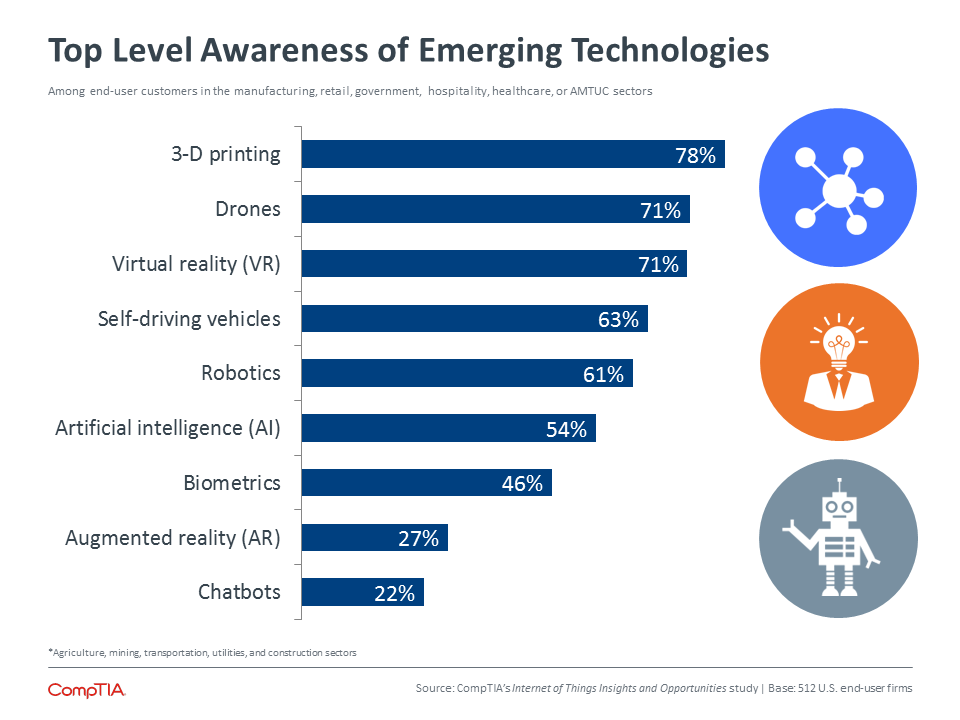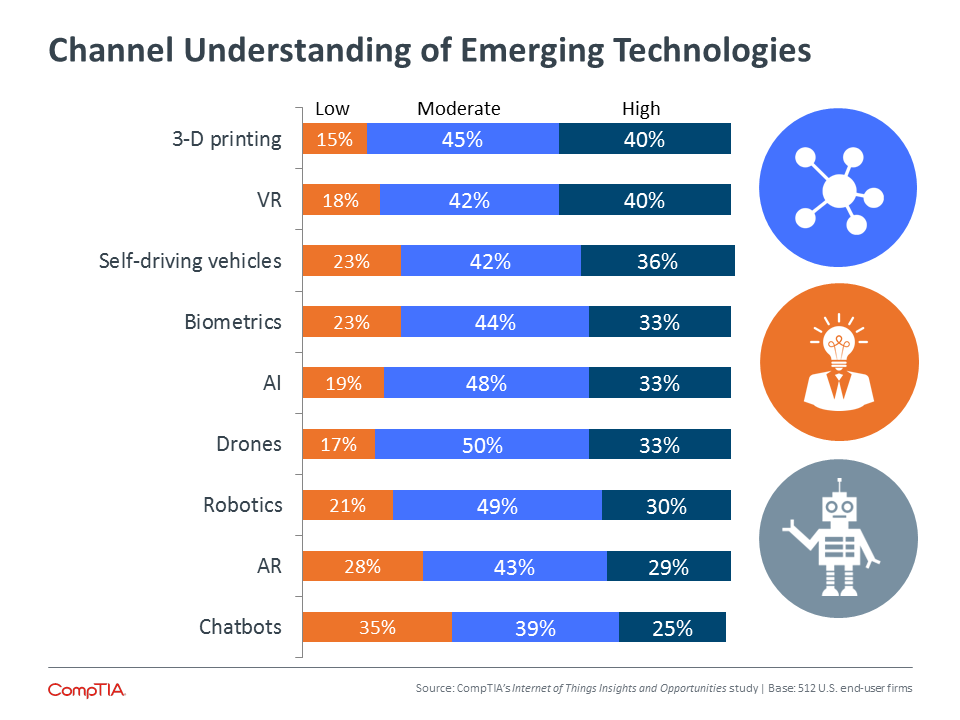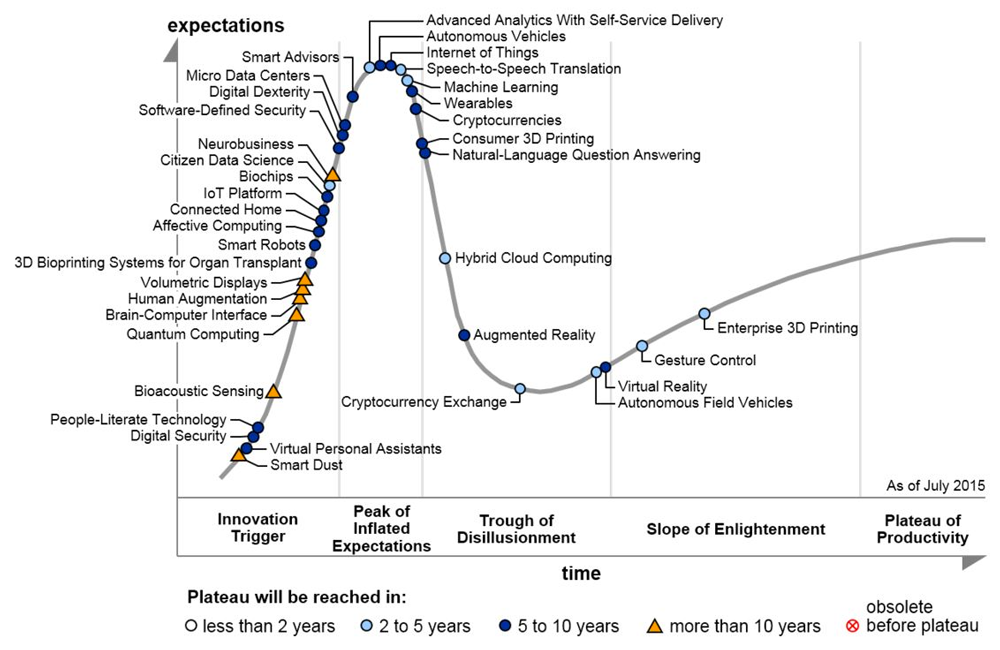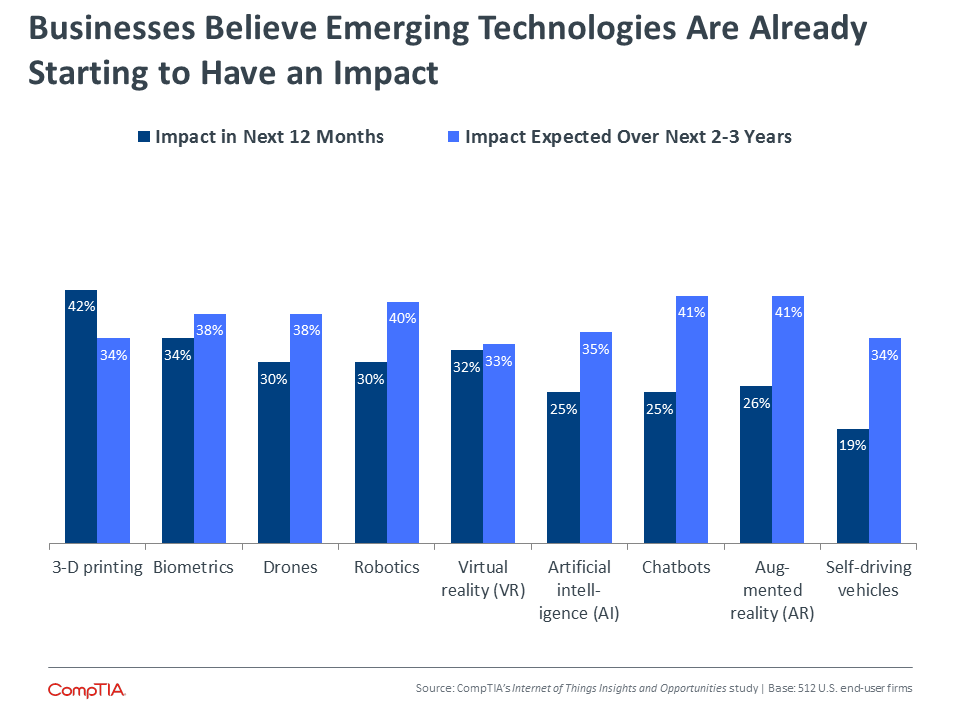Overview
Key Points
- As with Internet of Things, many emerging technologies are poised to make a splash in today’s digital society and digital organizations. End user awareness is generally healthy, and channel firms have some work to do to build up their expertise in these fields as customer interest increases.
- End users have a more bullish outlook when it comes to the potential business impact of future technology. Channel firms are likely more cautious based on experience integrating technology and making it enterprise grade, but they will have to find the middle ground between previous practices and experimentation, including the exploration of new vendors.
- While there is uncertainty around the impact of new technologies on the job market, CompTIA’s survey finds that most people believe that emerging trends will have a net positive impact. New technology may improve efficiency, but this is likely to lead to increased demand and innovative approaches.
Overview
CompTIA’s recent Internet of Things Insights and Opportunities study took a look at the emerging potential of the Internet of Things (IoT), a topic that has gained strong momentum over the past year. The study found that both channel firms and end users are well aware of IoT and beginning to pursue real business applications, pushing the trend past the hype into real utility.
But what about other emerging technologies? Lower barriers for entry and broader integration of technology in daily life are leading to rapid introduction of not only new products but also new macro trends. While the pace of new introductions may be increasing, this may not necessarily mean that the pace of business adoption is increasing. A wider variety of options may simply mean that more technologies fall by the wayside.


This churn leaves many businesses in a state of uncertainty. Without much precedent for determining long-term viability, many technologies appear promising at the outset. Without the proper skills to fully understand the new technology stack, imagining architectures with new components is challenging.
This research brief acts as a companion to the Internet of Things Insights and Opportunities study, exploring a variety of up-and-coming trends to determine which ones might have some staying power and when any impact might be felt.
Across the topics in CompTIA’s study, awareness among end users is generally healthy. Aside from biometrics, augmented reality, and chatbots, over half the sample had some knowledge of future trends either from direct experience or from reading news stories and conducting research. (Note: this study was conducting before the release of Pokémon Go, a game that thrust the concept of augmented reality into the headlines.) The high level of awareness is a testament to the way that technology—especially consumer technology—has become integrated into society. A decade ago, drones and artificial intelligence would have been reserved for trade publications; today, they make headlines in mass media.
Overall, channel firms’ understanding of these various technologies mirrors end user awareness. For each topic, there are a large number of firms with high or moderate understanding. Biometrics, augmented reality, and chatbots are once again the topics with the lowest overall knowledge base. However, it is interesting to note that few firms claim a high understanding of any given domain. Even 3-D printing, which is established enough to be questionable for an emerging tech list, is well understood by only 40% of the channel.
Other research firms have also been assessing the potential in emerging technology. Gartner’s Hype Cycle for Emerging Technologies identifies the same topics as CompTIA’s study, along with many other topics that are more granular or that have a longer runway before potential productivity. Most trends are packed tightly in a zone where expectations are high but the full business impact is still unknown.

Determining the business potential of various technologies starts with understanding the basics. Simply knowing where pieces fit in the grand IT ecosystem allows visualization of new business systems; deeper knowledge allows these systems to be built and integrated. The following section briefly describes each of these emerging trends, giving a sense of the role they may play in new strategies.
Emerging Tech Rundown

3-D Printing: Along with being the most well-established trend in this group, 3-D printing is perhaps the least IT-related. There is definitely interesting technology in the printers themselves, which deposit layers of material (typically some form of polymer) to create a physical object. But that physical object as an end result is an unfamiliar prospect not just for IT departments, but for any business that has not typically dealt with the manufacturing or production of devices.
3-D printing, then, still fits as an emerging technology because the business usages are still somewhat murky. The term “printing” suggests that traditional printer vendors and managed print providers can find opportunity in this market, but these channel firms must help their customers discover the ways that 3-D printing can be profitable.
As with many of these areas, much of the momentum around this trend has come from the consumer space, but enterprise interest is heating up. HP, a traditional printing powerhouse, announced in May 2016 that it would begin producing 3-D printers for industrial use.

Drones: While the military has been using unmanned aerial vehicles for some time, a different type of drone is rising in popularity. Thanks to the same advances in miniaturization that have enabled smartphones to be packed full of sensors and computing capability, model airplanes and quadcopters ranging from hobby-class to more industrial grade are filling the skies.
As with 3-D printing, business use cases appear limited to begin with. Currently, photography is the principal example, with delivery innovation lurking on the horizon. Before drones realize their potential, though, they face a major regulatory hurdle. The capability to put vehicles in airspace does not automatically come with the knowledge required to operate safely, and the Federal Aviation Administration (FAA) among others must determine what rules should be in place for drones and how those rules can be enforced.

Virtual Reality: It may still be a step removed from the Star Trek holodeck, but virtual reality has made major strides recently. Systems such as Oculus Rift, Samsung Gear, and HTC Vive are pushing the upper limits of the technology, and Google Cardboard is providing an entry-level experience for immersive environments.
With 360-degree cameras to capture the appropriate images or video and the necessary computing power becoming affordable, people are imagining how VR will revolutionize entertainment and maybe even communications. Businesses may be particularly interested in the communications possibilities as they continue to pursue the elusive goal of improving remote collaboration.
However, VR may run into the same issue that unified communications suites encountered. There is friction in changing patterns of communications, as people need to adjust to new tools and new behaviors. A form of friction is also present for VR entertainment—the high-end headsets must be tethered to high-end computers.

Self-Driving Vehicles: There is a huge amount of technology required to allow a car or truck on the road to be autonomous, so it makes sense that major technology companies such as Google and Apple are building or rumored to be building their own self-driving vehicles. Existing car companies are not out of the picture, though. From Lexus to Volkswagen to Ford, most manufacturers are gradually introducing autonomous capabilities. In the middle is Tesla, an upstart that made its name on electric vehicles and over-the-air software updates and is now using those updates to push self-driving features.
Like drones, self-driving vehicles will face regulatory hurdles. Decades-old laws will have to be revisited, and ingrained behaviors will have to change as well. But the potential benefits are enormous, especially as connected vehicles are able to interact with smart cities to drive data learning and efficiency.
Self-driving vehicles along with smart homes introduce an interesting question. Today, cars need mechanics and homes need contractors. Tomorrow, will these things need IT support?

Robotics: Robots fall into the same category as drones: technology that has been on the market in an advanced form for a long time but is now becoming ubiquitous as component costs drop and devices get more sophisticated.
Two items in particular are driving the rise of the robots. First, improved image processing allows for much greater awareness of the environment. This is enabled by stronger computing capabilities on the device along with connectivity to data sets. Second, new software techniques empower better decision-making capabilities and machine-to-machine (M2M) learning.
The net result is that robots are getting much closer to passing the Turing test, where it is difficult to distinguish the end results produced by a machine from those produced by humans. This report closes with a look at the natural fear that comes from this progress—the potential loss of jobs.

Artificial Intelligence: The software layer enabling improved capability in robots is one form of AI, but in a broader sense AI is a software construct that provides cognitive computing to technical tasks. Since so many daily activities are starting to include a technical component, AI is quickly becoming interesting as an assistant for digital life.
Sundar Pichai, Google’s CEO, has said that artificial intelligence will replace mobility as the next wave of technology. In a way, this may prove to be correct—as natural language processing and contextual computing improve, there could be less need for a device to be the primary interface. It seems more probable, though, that AI will be a new layer in the technology stack, something that sits between devices and applications to facilitate user activity.
Producing a core artificial intelligence function requires serious software skills and a massive data repository, and this implies that there may be only a few companies providing a core function with many others able to build services using APIs. Google is a strong candidate here, as well as IBM with Watson and Amazon with Alexa.

Biometrics: The old username/password combo has become untenable, with end users unable or unwilling to follow best practices for passwords across the myriad sites and services they use. Then, when best practices are not followed, it is a trivial matter to breach a given service with poor security and expose digital identities.
The reason that standard passwords have not faded into obscurity is that convenience trumps security. Without a forcing function, users will choose the simple, familiar option; and if the forcing function is too onerous, users will rebel. Biometrics has the potential to deliver improved security without placing a high burden on the user.
The interesting thing about biometrics is that the technology appears to mostly be in place. Apple’s Touch ID led the way on smartphone fingerprint recognition, and many other smartphone vendors have followed suit, but fingerprint scanners are also becoming standard issue at facilities such as day care centers. The issue for businesses may not be the technology or even the behavior of their users, but simply the cost and effort involved with transitioning to biometric security. This is the type of cost and effort involved in becoming a digital organization.

Augmented Reality: Virtual reality has gotten most of the headlines, but augmented reality may hold greater promise. Google Glass and Microsoft Hololens are two major products that have tried to bring AR to market, with both showing a wider range of potential uses than VR has demonstrated to date.
However, friction is still a problem for AR. The easiest way to have access to environmental information is to have an intermediary screen, and inserting a screen constantly or even situationally in the field of vision is problematic. Further refinements in technology will help make AR a more lightweight experience, and using smartphones for contextual information may grow in popularity.
Augmented reality could find success within specific verticals. There are obvious applications for doctors or industrial workers that need hands-free access to information. Companies that specialize in technology for a given vertical may want to pay attention to AR and think about possible innovative applications.

Chatbots: Even though AI itself is an emerging trend, chatbots have quickly gotten hot as a type of AI service. The idea behind chatbots is that users can speak with an AI through a standard messaging service using normal language. Rather than digging into an app to call an Uber or order food, you can do it through a chatbot.
The primary confusion around chatbots is how exactly they are accessed. Consumers have become accustomed to procuring separate apps for the different services they want to use, and they will likely assume that there are separate chatbots. Instead, companies are building their chatbots inside other platforms, such as Facebook Messenger or Google’s Allo. Ultimately, this consolidation is a key benefit to chatbots—one service can access a library of apps to simplify things for the user and also produce the best result. In the short term, this is just one more paradigm shift to absorb.
Assuming the chatbot experience becomes intuitive, it could have a big impact on IT professionals. Obviously there will be infrastructure support needed for any chatbot initiative, but chatbots can also actively be used by IT to supplement help desk efforts.
Business Impact
Perceptions about future business impact do not exactly track with levels of awareness. From the end user perspective, things start as expected. 3-D printing—the emerging tech that the highest number of businesses say they are aware of—is also seen by the most businesses as already having an impact. Second on the impact ratings, though, is biometrics: one of the bottom three technologies in terms of awareness.
The disconnect between awareness and perceived impact is not necessarily surprising; it is a disconnect grounded in historical attitudes towards technology. For the general public, deep understanding of technology was not always par for the course. It was more common to have a sense that certain technologies played a key role in IT strategies without knowing all the details.


Today, the situation is almost reversed. It is easy to become familiar with technology, and the natural reaction is to imagine significant business impact. So people feel that biometrics is having an impact without having much personal experience. Or, looking forward, large numbers of people believe that technology such as AR or self-driving vehicles will begin to have an impact in the next 2-4 years.
The channel balances this viewpoint somewhat. Having learned lessons around making technology fit inside businesses, there is a more measured approach in guessing what impact experimental trends might have. Near-term, the channel is seeing the same impact that end users are seeing. The future outlook is much more cautious.
The great debate is whether that caution is warranted or if the nature of enterprise technology has changed. The truth is probably somewhere in the middle. Improved technical literacy among the masses drives new behaviors—the reason cloud and mobility have introduced a new era of computing is not because of major advances in the technology itself, but because of the new approaches a company will take to their strategy. In addition, the diversity in technology creation broadens the range of applicable models and makes it likely that more trends will find traction.
On the other hand, making technology enterprise-grade is a legitimate hurdle. The ability to produce high tech at low cost opens the door to the consumer market, but the demands of that market are much different. Security, integration, and reliability are lower concerns (though they may become more critical for consumers in the future). In mature economies, there is also a substantial amount of legacy architecture and equipment to deal with. Building an approach from scratch using the most modern ingredients is a much different proposition from transitioning over to a new system from an old one with sunk costs and developed skills.
Discovering the balance between the consumer space and the enterprise will take a new way of thinking and some degree of experimentation. Part of that experimentation will be the exploration of new vendors and new channel partnering methods. Companies not traditionally associated with technology will potentially be part of new business systems, such as John Deere with autonomous farm equipment or Under Armour with biometric fitness devices. Finding the right vendors for new endeavors and building relationships will be a key activity for many channel firms.
One of the biggest potential impacts that new technology may have is on jobs, and this is also an area where it is difficult to properly project what that impact might be. Looking at the current course of automation, robotics, and artificial intelligence, it is easy to dream of a world where the majority of today’s tasks can be performed by machines. Other factors are in play, though, and professionals responding to CompTIA’s survey hold a different viewpoint.

Across different age ranges, respondents overwhelmingly believe that emerging technology will result in a net gain in available jobs. Undoubtedly there are still shifts in work assumed in this projection—routine manual tasks will continue to fade in favor of knowledge workers and creative activity—but the expected net gain suggests two things.
First, people may be counting on a continuation of the Jevons paradox, which states that increased efficiency leads to greater demand for a resource. Rather than dropping prices or reduction in labor, there is economic growth and continuation of many existing practices.
This leads into the second takeaway, which is that massive improvements in efficiency lead to unforeseen innovations. This can be applicable inside businesses, where new products and offerings can redefine a company. It can also be applicable in the job market. Many jobs were threatened by the technical advances of the Industrial Revolution, and those specific job categories saw reductions. However, entirely new categories were created, leading to a net gain in jobs and overall growth. The same will likely be true of the Digital Revolution, and those individuals and companies that experience the greatest success will be the ones that prove the most adaptable.
About this Research Brief
CompTIA’s Tech on the Horizon: From VR to Bots research brief examines technologies in pre-adoption stages. The study measures general awareness of different trends among channel firms and end users and gauges potential business impact.
The data for this quantitative study was collected in two parts.
Part 1: online survey conducted during May/June 2016. A total of 350 IT channel professionals in the U.S. participated in the survey, yielding an overall margin of sampling error at 95% confidence of +/- 5.3 percentage points. Sampling error is larger for subgroups of the data.
Part 2: online survey conducted during May/June 2016. A total of 512 business and IT executives (aka customers or end users) participated in the survey, yielding an overall margin of sampling error at 95% confidence of +/- 4.4 percentage points. Sampling error is larger for subgroups of the data. The study targeted the following industry sectors: manufacturing, retail, hospitality, healthcare, government and AMTUC (agriculture, mining, transportation, utilities, and construction).
As with any survey, sampling error is only one source of possible error. While non-sampling error cannot be accurately calculated, precautionary steps were taken in all phases of the survey design, collection and processing of the data to minimize its influence.
CompTIA is responsible for all content and analysis. Any questions regarding the study should be directed to CompTIA Research and Market Intelligence staff at [email protected].
CompTIA is a member of the Market Research Association (MRA) and adheres to the MRA’s Code of Market Research Ethics and Standards.
For additional insights into Internet of Things as one of the primary emerging trends, see the following reports and briefs available at CompTIA.org:
- Internet of Things Insights and Opportunities research study
- Internet of Things Ecosystem analysis
- Mastering the Internet of Things case study
- Building Smarter Cities research brief
Several icons used in this report were sourced from www.flaticon.com. 3-D printing, drones, connected car, robot, and biometrics by Freepik; virtual reality by Eucalyp; artificial intelligence by Smartline; augmented reality by Darius Dan; and chat by Vectors Market. The remaining icons were created by CompTIA.
Read more about Technology Solutions, Industry Trends.

 Download Full PDF
Download Full PDF